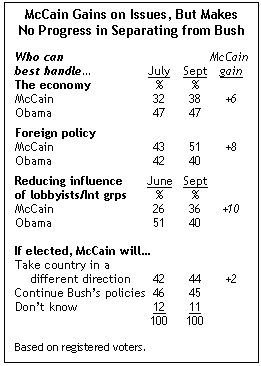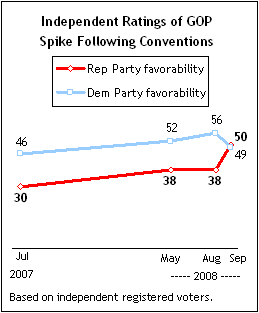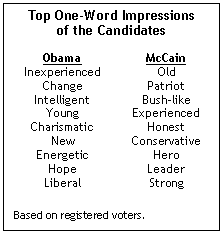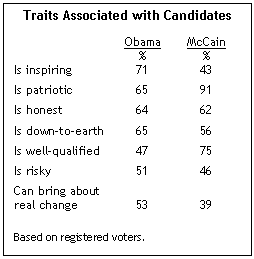Overview
With two eventful and closely followed political conventions now in their rearview mirror, voters’ views of Barack Obama and John McCain have changed in some ways, yet remain the same in others. What has not changed is that the race remains very close: a national survey of 2,509 voters interviewed Sept. 9-14 on both landline phones and cell phones finds that 46% support Obama, while 44% support John McCain. These results are almost identical to those in Pew’s pre-convention survey in early August, which had 46% backing Obama and 43% McCain.

When the current survey of registered voters is narrowed to those most likely to vote, the margin between the candidates contracts further. Among 2,307 likely voters surveyed, the race is tied at 46%-46%.
Although bottom-line voter attitudes have changed little since early August, the new survey finds that McCain has made considerably more progress than has his opponent in changing fundamental attitudes toward his candidacy. Yet the race remains close largely because Obama continues to be seen as the candidate of change, and voters remain divided over whether McCain would govern differently than President Bush.

Nonetheless, McCain’s recent achievements are clearly evident. First, Republican voters are much more politically energized than they were prior to the conventions. A greater percentage of GOP voters believe that it “really matters” who wins the election (71% now vs. 62% in June); far more also express satisfaction with their presidential choices than in June (74% vs. 49%).
McCain also garners more strong support and more positive support from his backers than he did a month ago. The percentage of voters saying they back McCain strongly climbed from 17% in August to 25% currently. McCain’s increase in strong support has been particularly apparent among Republicans, white evangelical Protestants and white Catholics.

Second, the Republican candidate has increased voter confidence in his ability to deal with a number of key issues. While pluralities still favor Obama to deal with the economy and energy, McCain reduced his rival’s margins on these two top domestic issues. The Arizona senator has also all but eliminated Obama’s wide advantage in being seen as the candidate best able to reduce the interests of lobbyists and special interests in Washington.
At the same time, McCain increased his lead on national security and foreign policy issues. His current advantages over Obama on terrorism and foreign policy – 25 points on terrorism and 11 points on foreign policy – are on par with President Bush’s leads over John Kerry on these issues at this stage in the 2004 campaign.

McCain may also have improved the GOP “brand,” which had steadily eroded during Bush’s second term. Half of registered voters now express a favorable opinion of the Republican Party – the party’s highest rating in three years. The Democratic Party continues to have a more favorable image (55% favorable), but the gap between the two parties has narrowed considerably since earlier this year.
Equally important, independent voters now express about the same view of both major parties: 50% of independents have a favorable opinion of the Republican Party while 49% feel favorably toward the Democratic Party. As recently as August, positive ratings for the Democratic Party surpassed the GOP’s by 18 points (56% to 38%).
In contrast with McCain, Obama has made only modest progress coming out of his convention. Since early August, Obama has gained increased support from Democratic voters, including former backers of Hillary Clinton. However, while support for Obama among Clinton’s former backers has increased slightly from 72% to 78%, this is still well below the level of support McCain enjoys from supporters of his former primary rivals (91%).

Obama continues to hold the advantage over McCain on nearly every domestic issue. Obama has double-digit leads over his opponent as the candidate best able to improve education and healthcare, and to deal with environmental issues. And while he has lost ground to McCain on the economy, he still is favored by 47% to 38% on this issue, which tops the list of voter concerns.
As has been the case throughout the campaign, Obama’s strong suit is in being seen as the candidate most likely to bring about change. And Obama’s biggest weakness continues to be the widespread belief he is not as qualified as McCain. Fewer than half of voters (47%) say the trait “well-qualified” applies to Obama, compared with 75% who say it describes McCain.

In this and other respects, voters’ assessments of the strengths and weaknesses of the candidates have been stable for much of the campaign. Far more voters view Obama as inspirational and down-to-earth than say these traits apply to his opponent. Far more voters view McCain as patriotic than say that about Obama.
The conflicts and cross-pressures facing many voters – especially swing voters – in assessing the candidates’ strengths and weaknesses are reflected in important ways. First, sizable percentages of all voters describe both candidates as “risky” – 51% of voters say this describes Obama, while nearly as many (46%) say it applies to McCain. Among swing voters, 53% see Obama as risky, compared with just 41% who view McCain this way.
Yet somewhat more swing voters (46%) say their greater concern is that McCain will govern too much like President Bush, rather than that Obama lacks experience (37%). Nearly one-in-five swing voters (17%) offered no response about which concerned them more.
Palin Enthuses Reps, Attracts Independents
Sarah Palin, the Republican vice-presidential nominee, may well be contributing to some of the positive trends for McCain’s candidacy. Overall, 54% of voters hold a favorable view of Palin, which is about the same percentage as express a positive view of Democratic vice- presidential candidate Joe Biden (52%). However, the Alaska governor’s favorable ratings are sharply higher among conservative Republicans and white evangelical Protestants, who now express much stronger and more positive support for McCain than they did prior to the Republican convention.

Notably, 22% of all McCain supporters say they “almost wish” Palin were the GOP nominee instead of McCain. Just 10% of Obama supporters express the same sentiment about Biden. White evangelical Protestants, in particular, react positively to the prospect of Palin leading the GOP ticket: 27% of white evangelical supporters of McCain say they almost wish Palin could be the nominee, compared with 18% of white Catholics and 16% of white mainline Protestants who back McCain.
Palin appears to have brought additional benefits to McCain, beyond increasing enthusiasm for his candidacy among Republicans. Independents, who on balance favor McCain in the horserace, have a particularly positive opinion of Palin (60% favorable). McCain trailed slightly among independents in August (by 45% to 41%), but now holds the edge over Obama among this group (by 45% to 38%).
While Palin is viewed more positively by voters in her own age cohort, she draws about the same favorable ratings among women (53%) as among men (56%). And while less educated whites give the Alaska governor higher than average ratings, former supporters of Hillary Clinton are not particularly drawn to her. Perhaps predictably, Democrats – especially liberals – are highly critical of Palin; she also gets particularly low ratings from voters younger than 30.
Voting Blocs: Then and Now
There are a few demographic groups that stand out in the current race when compared with the 2004 election. Yet most of the patterns of support for Obama and McCain reflect long-standing trends in voting behavior:
Age – Obama is running even better among voters under 30 years of age than did Kerry, who led Bush by 54% to 45% among voters younger than 30, according to 2004 national exit polls. Obama currently leads by 60% to 31% among this group.
Region – Compared with Kerry, Obama is running better in the Midwest and the West. Obama holds a small lead among Midwestern voters (48%-40%); four years ago, Bush narrowly carried voters in this region (51%-48%). Obama has a narrow edge in the West (51%-43%); in 2004, the West divided its votes nearly evenly between Bush and Kerry.
Gender – The gender gap is slightly larger today than it was four years ago on Election Day. McCain holds an eight-point lead among men but trails among women by 10 points. Bush beat Kerry by 11 points among men and trailed Kerry by three points among women. However, McCain holds a 48% to 41 lead over Obama among white women, who also backed President Bush over John Kerry – 55% to 44%.
Religion – McCain’s support among white evangelical Protestants, a key Republican voter group, has inched up to 71% (Obama is supported by 21% of evangelicals). Based only on voters who express a preference between the two candidates, McCain’s lead among evangelicals (77%-23%) is comparable to Bush’s final margin among this group (78%-21%). McCain has a small edge among white Catholic voters, 48% to 41%. He also holds a clear lead among white Catholics who attend Mass at least weekly (52% McCain vs. 36% Obama). Four years ago, Bush beat Kerry 61% to 39% among this group.
Race – White voters support McCain over Obama by a margin of 52%-38%, unchanged from August. Obama’s large lead among black voters (89%-5%) is also unchanged from a month ago. These leads are comparable to the results in 2004, according to the exit polls.
Other Findings
- The race is now dead even in the battleground states (45% to 45%). Obama held a 47% to 40% lead among voters in these states in Pew’s early August poll.1
- When asked to identify Obama’s religion, a small but consistent minority of voters say that Obama is a Muslim. Currently, 13% assert incorrectly that Obama is a Muslim, which is virtually unchanged from June; in March, 10% said that Obama was a Muslim.
- Three-in-ten voters say that chances of another terrorist attack would increase if Obama is elected. An even higher percentage (42%) expresses concern that McCain will take the United States into another war.
- Most voters say that both Obama and McCain would be able to work well with the political opposition. Roughly six-in-ten (61%) voters say Obama would work well with both Republicans and Democrats; a comparable percentage (59%) says the same about McCain.
- Opinions about the candidates’ wives are positive, and have improved since earlier in the campaign. Currently, 56% of voters express a favorable opinion of Michelle Obama while 52% have a favorable opinion of Cindy McCain.